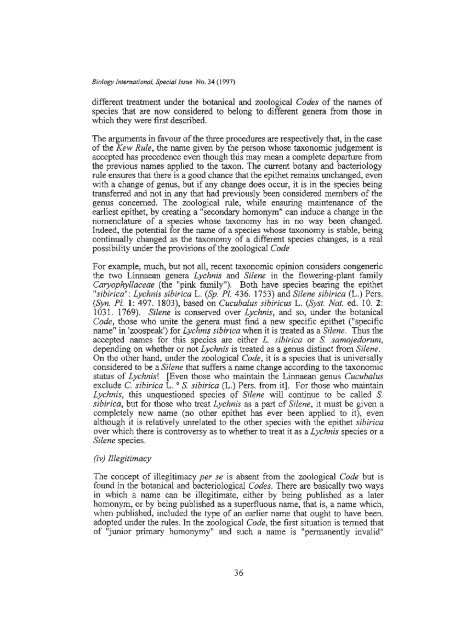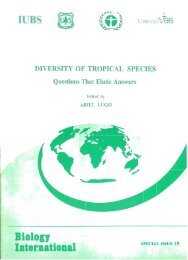SPECIAL ISSUE 34a.pdf - Biology International
SPECIAL ISSUE 34a.pdf - Biology International
SPECIAL ISSUE 34a.pdf - Biology International
You also want an ePaper? Increase the reach of your titles
YUMPU automatically turns print PDFs into web optimized ePapers that Google loves.
<strong>Biology</strong> <strong>International</strong>, Special Issue No. 34 (1997)<br />
different treatment under the botanical and zoological Codes of the names of<br />
species that are now considered to belong to different genera fiom those in<br />
which they were first described.<br />
The arguments in favour of the three procedures are respectively that, in the case<br />
of the Kew Rule, the name given by the person whose. taxonomic judgement is<br />
accepted has precedence even though this may mean a complete departure fiom<br />
the previous names applied to the taxon. The current botany and bacteriology<br />
rule ensures that there is a good chance that the epithet remains unchanged, even<br />
with a change of genus, but if any change does occur, it is in the species being<br />
transferred and not in any that had previously been considered members of the<br />
genus concemed. The zoological rule, while ensuring maintenance of the<br />
earliest epithet, by creating a "secondary homonym" can induce a change in the<br />
nomenclature of a species whose taxonomy has in no way been changed.<br />
Indeed, the potential for the name of a species whose taxonomy is stable, being<br />
continually changed as the taxonomy of a different species changes, is a real<br />
possibility under the provisions of the zoological Code<br />
For example, much, but not all, recent taxonomic opinion considers congeneric<br />
the two Linnaean genera Lychnis and Silene in the flowering-plant family<br />
Caryophyllaceae (the "pink family"). Both have species bearing the epithet<br />
"sibirica": Lychnis sibirica L. (Sp. Pl. 436. 1753) and Silene sibirica (L.) Pers.<br />
(Syn. PI. 1: 497. 1803), based on Cucubalus sibiricus L. (Syst. Nat. ed. 10. 2:<br />
103 1. 1769). Silene is conserved over Lychnis, and so, under the botanical<br />
Code, those who unite the genera must find a new specific epithet ("specific<br />
name" in 'zoospeak') for Lychnis sibirica when it is treated as a Silene. Thus the<br />
accepted names for this species are either L. sibirica or S. samojedorum,<br />
depending on whether or not Lychnis is treated as a genus distinct from Silene.<br />
On the other hand, under the zoological Code, it is a species that is universally<br />
considered to be a Silene that suffers a name change according to the taxonomic<br />
status of Lychnis! [Even those who maintain the Linnaean genus Cucubalus<br />
exclude C. sibirica L. O S. sibirica (L.) Pers. fiom it]. For those who maintain<br />
Lychnis, this unquestioned species of Silene will continue to be called S.<br />
sibirica, but for those who treat Lychnis as a part of Silene, it must be given a<br />
completely new narne (no other epithet has ever been applied to it), even<br />
although it is relatively unrelated to the other species with the epithet sibirica<br />
over which there is controversy as to whether to treat it as a Lychnis species or a<br />
Silene species.<br />
(iv) Illegitimacy<br />
The concept of illegitimacy per se is absent from the zoological Code but is<br />
found in the botanical and bacteriological Codes. There are basically two ways<br />
in which a name can be illegitimate, either by being published as a later<br />
homonym, or by being published as a superfluous name, that is, a name which,<br />
when published, included the type of an earlier name that ought to have been.<br />
adopted under the rules. In the zoological Code, the first situation is termed that<br />
of "junior primary homonymy" and such a name is "permanently invalid"




